
by wemakedo | Sep 20, 2019 | health, Plastic Free July, transport |
To whom it may concern at Aer Lingus,
I recently used your new transatlantic service from Dublin to Seattle and I found the service to be very good, in keeping with what I have come to expect from AerLingus as Ireland’s national carrier and a 4-star airline.
However, I am writing to highlight one aspect of your service that I was very disappointed with.
That is the amount of consumer plastic waste being generated on each crossing on this route.
Here is will highlight some specific areas that I noted on the flight which could be easily addressed and then I will finish by proposing that AerLingus has an opportunity to take a leading stance in improving on the waste generated from its inflight service when other airlines seem to be ignoring this very “front of house” and sadly very wasteful aspect of the service.
Firstly the travel blanket supplied to each customer is wrapped in a plastic bag only to be immediately removed and trashed without a second thought. I took a mini poll of other travellers to ask their opinion of the use of this wrapping. All (only 4 travellers) felt that this attempt to make one feel that blanket is “fresh” and “clean” is unnecessary when considering the resulting 300 bags being dumped from each flight. Perhaps there would be a less impactful way to convey to passengers that these blankets are fresh when received? Even a paper bag if a bag was really thought to be necessary?
Next each cup of hot beverage used was given in a disposable plasticised cardboard mug along with a plastic lid. I recall on flights taken in previous years where the drink could be poured into the cup received on the food tray and no plastic lid was required. Here I am considering the 300 (or perhaps multiples of 300) lids and cups being dumped from each flight. Perhaps even encouraging passengers to reuse these cups if they intend to have a second cup of tea/coffee might at least give a positive message and make passengers at least aware of the cumulative waste being generated. Perhaps a bring your own mug program could even be somehow incentivised (I know that we did on our flight and I noticed others doing this)
Next, the headphones provided to each passenger came in a disposable ziplock plastic wrap. This was immediately opened and 300 wrappers dropped/stuffed into pockets on the plane. Is this wrapping really helping anyone? On other airlines, I have noted that the unwrapped headphones were handed out after takeoff or simply left unwrapped on the seat, thereby avoiding yet another source of near-useless but highly damaging plastic wrapping.
Of course, then there was the food tray – a sea of single-use plastic. This is a more difficult one to address given the obvious constraints that airlines face in having to provide this service without adding to the service overhead for the flights. I do feel however that instead of following what other airlines have always done, there is room for AerLingus to lead the way in trying to slowly address the amount of disposable plastic arriving in each meal serving.
I did note on my flight that the second snack offered, was provided in a cardboard container without any plastic. Whether an intentional effort was made to reduce plastic in selecting this or not, I for one appreciated it.
I feel that more choices like this could form part of a concerted campaign on your part to address the amount of waste generated during flight and could be highlighted as part of a broader effort on behalf of Ireland’s “green” airline to make industry-leading efforts to be “green” in all aspects and to change the way inflight service is provided. The public relations benefit could be appreciable if AerLingus were to have an environmental impact statement with a declared intent to try to address inflight waste as well as perhaps the other impacts from the business process. I looked for but could not find any such statement online – nor could I find one for your nearest competitors either.
In fact I noted that a competitor of yours (Ryanair) was recently highlighted as one of the worst carbon polluters in Europe (not just of airlines but of all businesses). The air pollution aspect of flying is clearly a very difficult issue to tackle but I am urging you to tackle the easier and more obvious side of the inflight experience and thereby send a strong message to consumers.
You likely don’t need to hear yet another person reminding you of the effects of air travel on the environment, and as a user, I hold my hand up and will admit that I am a somewhat frequent user. But like many of us who feel we need to fly, I do think that there is a lot of scope to clean up the secondary waste stream being generated on these flights for no real gain to the consumer and perhaps at a cost to the airline (for example, time spent cleaning it up and disposal costs as well as no PR benefit).
AerLingus prides itself on its customer service and I note you are recognised for providing a 4-star service. Therefore I can understand someone making the decisions to use wrapping to add to a quality feeling that you think passengers are seeking. But I really feel this is misguided in its intent as many travellers these days are quite concerned about the overall impact of this form of transport and these methods have the very bad effect of delivering lots of additional plastic waste into our overburdened world.
I respectfully ask that you don’t ignore this request from a concerned customer and that even if you decide not to directly address these concerns (not just mine I assure you), that this concept could be taken on board and incorporated into your longer-term planning as to how you want to improve your future service. Perhaps AerLingus could take a lead that others might choose to follow.
I look forward to hearing more about what AerLingus can do to help alleviate the damage from this service in some small regard.
Yours sincerely
etc…
submitted to Aer Lingus customer care on September 19th.
By the way, the image at the top is from a report about a small Portuguese airline that took the action to make their service plastic-free this year. Seems like it can be done. If this really seems trivial compared to the impact of flying itself, then think of the simple message if gives to so many people who choose to fly – i.e. the potential effect it could have on passengers thinking by simply making this statement so clearly.
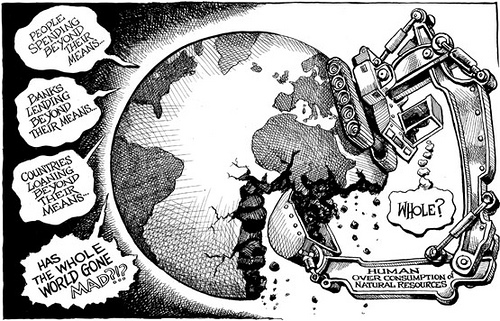
by wemakedo | Nov 9, 2018 | community, health |
By now I think most of us have at least seen headlines related to the recent IPCC update on climate change which describes the impacts of further global warming. To add to this, more recently, the World Wildlife Federation (not to be confused with the wrestlers) released their latest 2 yearly report on the state of our wildlife. Both of these reports are truly shocking in the facts that they present. And it should be noted that although there is some opinion included, these reports are summaries of the best factual data we have on our current situation. If people need more evidence of the sorry state of our global environmental health, it’s all here.
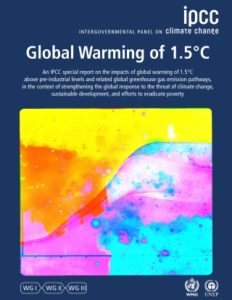 And let’s be honest with ourselves – in both reports the current situation and the prognoses are both presented as dire situations.
And let’s be honest with ourselves – in both reports the current situation and the prognoses are both presented as dire situations.
And these are not the kind of “dire” situations where for example, jobs are lost or economies are down turning or prices are rising or a storm is coming or some of the other crisis events that preoccupy our media all the time. This is on a whole other level, like the destruction of the planet level. I don’t know whether humanity has ever before knowingly faced such a huge imminent problem and responded with such an apparent lack of urgency.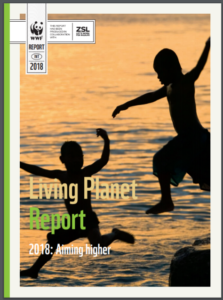
Is this sinking in at all?
For those who are perhaps climate change sceptics or merely indifferent to it all, and feel that consequences that are still years away are not to be taken too seriously, then the WWF report makes our situation clear and the cause of this situation even clearer. The report directly blames our consumption habits: “Runaway consumption has decimated global wildlife, triggered a mass extinction and exhausted the Earths capacity to accommodate our expanding appetites”
As the head of the WWF declares ominously in the report, “we are the first generation to know we are destroying our planet and the last one that can do anything about it”.
Why are we not all talking about this with the urgency it deserves ???
Why is our media not saturated with more discussion on this?
For some perhaps these are just yet more of the same kind of reports that preach doom and gloom, and that we need to do our best to not get dragged down by. But for those who are listening to the message contained here, there is a lot to be very worried about now and alot that we should be taking far more drastic action on.
We are clearly in a crisis situation that we are either paralyzed to act on or simply too self-absorbed to even notice despite the very clear warnings we are now getting.
It seems like most of us are hearing this message and choosing to believe that life will just go on as normal, the way it always has. Perhaps we are tending to make a subconscious decision that we can’t affect this with our individual habits anyway or that if it really was such a big deal wouldn’t our government be taking more radical action on this on our behalf?
This thinking is starting to look very foolish and delusional.
Mrs Wemakedo has recently gone back to school for some new learning on environmental engineering and so she has been reading a lot of the latest thinking on the state of the environment and latest efforts to mitigate our destructive impacts. So we have been discussing some of these concepts at home a little more and let’s just say that a quiet air of foreboding has begun to set in for us.
On some level, it’s consoling at least to see the huge amount of investigation, analysis and planning that is taking place in various fields of industrial and commercial activity to try to get a handle on the environmental side effects of our economic activity. But this seems minuscule in comparison to the huge momentum already built up by the destructive methods we have engaged in unchecked for so long now.
The latest IPCC report is attempting to put in clear terms what needs to happen to avoid near certain disaster for much of the world’s population. It lists climate-related risks to health, livelihoods, food security, water supply, human security and economic growth. That pretty much covers a lot of what we consider important in life, so maybe we should listen harder this time? Avoiding these catastrophic scenarios will require far-reaching and unprecedented changes in society!!
The WWF report is equally stark. Since 1970, we have now wiped out an estimated 60% of all creatures with a backbone (vertebrates) due to our unrelenting destruction and pollution of the environment.
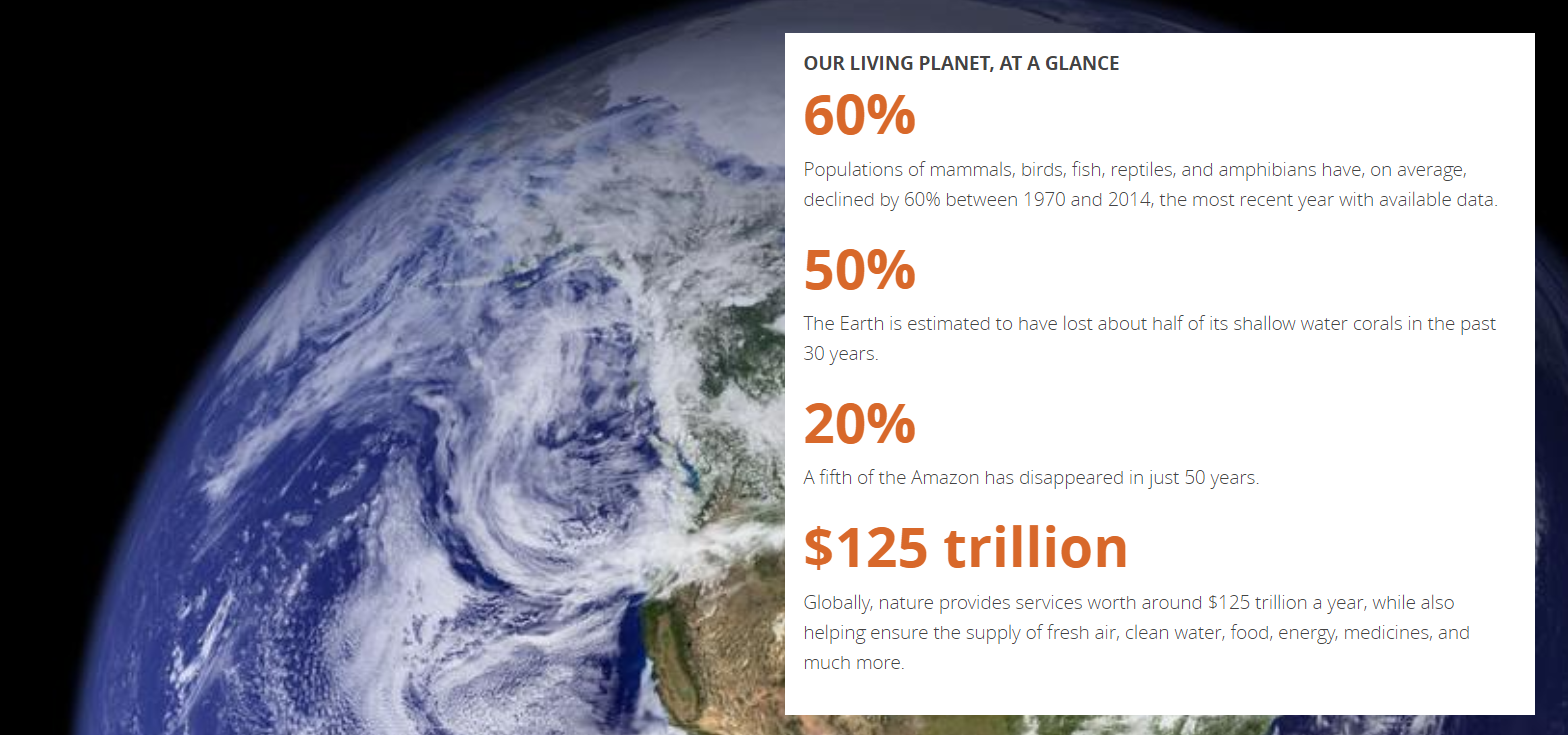 A little background on the IPCC report: this report was commissioned in 2015 after the Paris Climate Accord when it was not really clear what would happen if the world were to limit the global temp increase to 1.5C above pre-industrial temperatures (before 1900) versus limiting it to 2C. This report was requested to go figure out the real world scenarios in both cases.
A little background on the IPCC report: this report was commissioned in 2015 after the Paris Climate Accord when it was not really clear what would happen if the world were to limit the global temp increase to 1.5C above pre-industrial temperatures (before 1900) versus limiting it to 2C. This report was requested to go figure out the real world scenarios in both cases.
It doesn’t sound like much but keep in mind we are now (2017 data) believed to be at about 1C higher (within 0.8 to 1.2C (– high confidence)) already and accelerating! Some climate scientists are adamant that we are even higher if a less conservative analysis is applied to the available temperature data.
The CO2 level is not static or even slowly rising – this is actually ACCELERATING according to the latest data collected.
The report makes it clear that if we stopped emitting CO2 now, that is, immediately went to a zero Carbon society across the globe, that the impacts of what we have done will persist for decades and likely millennia in the form of environmental damage. If you pause and think about this it’s very worrying in itself…but then consider how well we are doing at slowing this down for the future.
It’s simply not happening.
As one researcher said “we are sleepwalking to a disaster with climate change”. And here is where the really concerning findings occur.
If we were to limit the damage to the scenario of a 1.5C increase then we would have to be at zero Carbon output by 2050!. That’s dropping from the highest CO2 output levels we have ever experienced to zero in just over 30 years!
The report estimates that we will reach 1.5C above pre-industrial levels (from the current 1C) by somewhere between 2030 and 2052.
So in the next 12+ years, we will see the far more serious consequences of this unchecked behaviour.
Let’s take an example from the report to get some idea of what this could mean. At the 1.5C mark, it is estimated that we lose 70 to 90% of the worlds coral reefs…that’s 90%!.
At 2C, this goes to 99%. No more coral reefs.
For many of us, it’s hard to identify with this as we likely won’t suffer much directly from having no more coral reefs – those pretty features favoured by underwater documentary makers. But to say that we might just be about to permanently kill them all off without much of a second thought is distressing. For those with children, imagine how you would explain this to your kids….”yeah, we knew it was happening but didn’t seem bothered enough or organized enough about it at the time to do enough to stop it”.
The report even mentions the use of extreme “geoengineering” as one possible solution to be considered given the dire situation we face. A quick internet search reveals that this is not a new concept to try to tackle the problem but is one that is now being mentioned more frequently as those in the know realise that this intractable problem looks to be one that is just that – intractable. We really just can’t seem to help ourselves.
One of the geoengineering ideas floated is to fill the clouds with Sulphur to mimic what happens after major volcanic eruptions when sulphur dioxide is ejected into the atmosphere and converts to sulphuric acid which is then able to reflect back lots of sunlight leading to a large temperature drop. It has worked during previous large-scale eruptions so could possibly be made to work artificially. However as these articles point out, if this could be done and if it was to work, this would only buy some time to fix the underlying CO2 generation problem but if you stop doing this engineering without having changed the background CO2 problem then the sudden temp change would have “disastrous effects” on our climate. It’s a last resort option to avoid the 2C temperature rise scenario, and one that needs a lot more figuring out, but maybe we need to start thinking in terms of last resorts now.
ref : https://earther.gizmodo.com/the-machines-that-could-darken-the-sun-to-stop-climate-1825452265
The world is full of legacy systems and methods that have been handed down to us as “the way things are done”. Knowing the way to do things from our predecessors allows us to go further and make progress in different areas without having to spend time relearning the basics. It’s how we progress
But then we also know the benefits of being able to disrupt the status quo with innovative thinking – take for example the prestige associated with an entrepreneur realizing that they can achieve some economic output in a far better way than before. These people are our modern day heroes.
Shouldn’t this disruptive spirit be channelled more urgently towards this crisis situation we face?
We have adopted some truly terrible ways of doing things that we seem to be unable to even acknowledge, much less be bothered trying to disruptively change them. Unfortunately, there are many agents who are incentivized to ensure that you don’t think too hard about some of these behaviours and question the methods that have been handed to you as, simply, “the way things are done”.
Think about the way cigarettes were sold to the public and how long it took before the medical evidence was able to break through the momentum this industry had built up on the back of high profits.
Think about the way cars are sold to us as, electronics and so much of the other crap we digest at increasing rates.
Think about the consumption of non-essentials in general. The only model we know seems to be to sell more stuff to more people to make more money. Where is this approach leading us? These reports are laying that destination our clearly for us now in ever more dramatic terms.
We should not be so naïve as to think that the way we are shown to behave by those with strong incentives, is in any way aligned with our best interests. And it would seem that we don’t yet see how closely our own best interests and the environment’s best interests are intertwined. If we were being trashed by hurricane storms with increasing frequency in Ireland would we start to wonder more about why this was happening? Woud we thne feel the need to take more personal action on our daily habits?
Where has our critical thinking gone in order to be able to see what is going on around us at a time when it’s not possible to hide all this evidence any more
Recently we watched a BBC documentary about the damage being done by the fashion industry. It was shocking for two reasons. The first reason was that it has extremely high levels of chemical pollution associated with its processes which seem to be going unchecked and at the same time that industry has managed to trick us into wanting new clothes at much faster rates than before…
so what you may say? many industries have managed to quietly pull this trick on society with their own particular play on our needs and insecurities.
But what was really shocking is how well the fashion industry seems to have managed to keep this one out of the limelight. At least for us as we watched it, we were shocked to realise how bad that industry really is while maintaining a relatively clean image. Remember when we became aware that some clothing companies were using child labour to make clothes, and how quickly public pressure came to bear to try to stop that practice?
Well, all the while the clothing production companies have been quietly trashing their local environments while helping eager high street buyers stay “up to date”. This documentary is worth a watch if you need some more shocking evidence of why a seemingly benign industry is, in reality, doing horrendous damage… second only to transport in the level damage that it does (link)
Taking time to look around, the environment seems like just one of the many problems we face. But as these two reports are clearly telling us, we need to stop ignoring or underestimating the severe consequences of what we are doing to the planet. If there is a solution to this it lies in our individual habits….no self-interested government is going to fix this. On a local level, people may have forgotten that improvements that get made by governments only come about in response to public demand. The urgent change needed will only happen through people taking their own actions to change.
We must realise that the effects of the environmental damage we are doing are no longer far removed from us in the first world. We are in a crisis that now needs an individual response. As both these reports make clear, we are at the point where we may be the last generation that can possibly do enough to reverse this.
We’ve heard the message again and again. How much more convincing do we need?
We shouldn’t need to be forced to act in the best interests of our future.
by wemakedo | Feb 20, 2017 | health |
Home water quality is important and for us it was an issue.
When we first built our house back in 2010 we opted for installing a well on our property as connecting to the local water mains was just too expensive – it was too far from our house to connect in at a reasonable cost. Plus the idea of having control over our own supply was in keeping with our self-sufficient approach.
When the well was sunk to a depth of 200ft we felt happy that the drainage through that amount of ground would do a good job of filtering 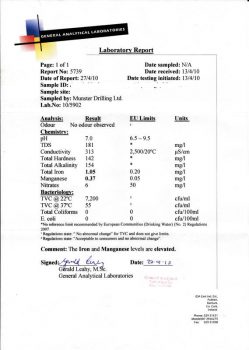 out any nasty stuff that the local landowners might want to dump on the land.
out any nasty stuff that the local landowners might want to dump on the land.
Unfortunately we were in an Iron rich area and so the water, although quite drinkable and clear had a relatively high iron and Mn content and also elevated hardness. Iron is classified as a secondary contaminant as it is does not impact health but is more a cosmetic and taste issue. When drinking a glass of water tastes like you have a bloody lip, then you just tend to avoid it!
On the advice or our plumber at the time, we went with some large passive filters to clean it up. This triple filter system (shown), used a first stage sediment mesh filter to remove particulates, a second stage carbon filter to remove contaminants by chemical adsorption and finally a third stage filter designed to remove Iron(Fe) and manganese (Mn).
 According to the supplier of the cartridges, which cost about Euros200 to replace, they should last up to a year for a house of 5 with typical consumption. Unfortunately for us we found that the problems with iron staining of our sinks, toilets and clothes never quite went away. In contrast, the hardness (Calcium carbonate) wasn’t much of an issue as it was not very high and it also adds a crisp freshness to the water flavor.
According to the supplier of the cartridges, which cost about Euros200 to replace, they should last up to a year for a house of 5 with typical consumption. Unfortunately for us we found that the problems with iron staining of our sinks, toilets and clothes never quite went away. In contrast, the hardness (Calcium carbonate) wasn’t much of an issue as it was not very high and it also adds a crisp freshness to the water flavor.
The carbon and sediment filters we installed appeared to be doing their job, but the iron filter simply wasn’t up to the task. On doing some research it seems there are different varieties of iron contamination in Irish water.
Water that comes out of the tap clear, but turns red or brown after standing contains “ferrous” iron. Water which is red or yellow when first drawn is “ferric” iron. Iron can form compounds with naturally occurring acids, and exist as “organic” iron. Organic iron is usually yellow or brown, but may be colorless. For the chemists: ferrous indicates Iron in a +2 oxidation state while ferric is iron in a +3 oxidation state. As far as we could tell, we had ferrous iron and the most commonly recommended way to remove it is by using a water softener (ion exchange resin based).
The presence of Mn will tend to create some black stains, and can give the water a bit of a bad smell, making your glass of water with meals even less appealing than the iron already makes it. Although both iron and manganese are harmless to health at these levels (1ppm and 0.37 ppm respectively), their combination in drinking water is a real problem – in that you won’t want to drink it. This is a bad situation with kids when you want to encourage to drink lots of water and less of the sugary alternatives.
When one goes looking for solutions, there seems to be much scaremongering about how specialized the water cleaning technology is. On making enquiries, we kept hearing that one daren’t make a purchasing decision without talking to “the experts” who want to sell you their specialized system that is perfect for your needs.
We received quotes from €900 to €1500 for a softener/ion exchange unit to fix our problem! Significantly more than we expected to pay for technology that seems really quite simple.
As with many other household technologies, the amount of available information online is helping to address the lack of information which forces buyers to be cornered into paying high prices. This is the rather excellent leveling effect of free information.
Armed with the knowledge that we had ferrous iron and manganese to remove as well as some hardness, we were able to avoid that first costly barrier of not knowing what we needed. That ignorance can unfortunately lead to some businesses taking advantage of those who come with a “can you understand and fix my problem for me” approach.
We found these guys (www.water2buy.ie) offered a high quality product and service designed for those willing to handle some of the leg work. Having spotted a sale price earlier in our searches, when we went back to finally make a purchase, that sale price was gone, but we were delighted that they were open to negotiation and in the end we got our new system delivered for €450 instead of the advertised €600. A whole lot less than our first enquiries forecasted.
The people at Water2buy.ie were able to assess our water analysis test results to confirm that this particular ion exchange resin would fix our problems which turned out to be correct. In the back of my mind I knew that once you have the hardware (a sealed cylinder, valves and plumping) that changing this particular resin for another option is relatively easy should there be issues later. So we felt quite happy to purchase without b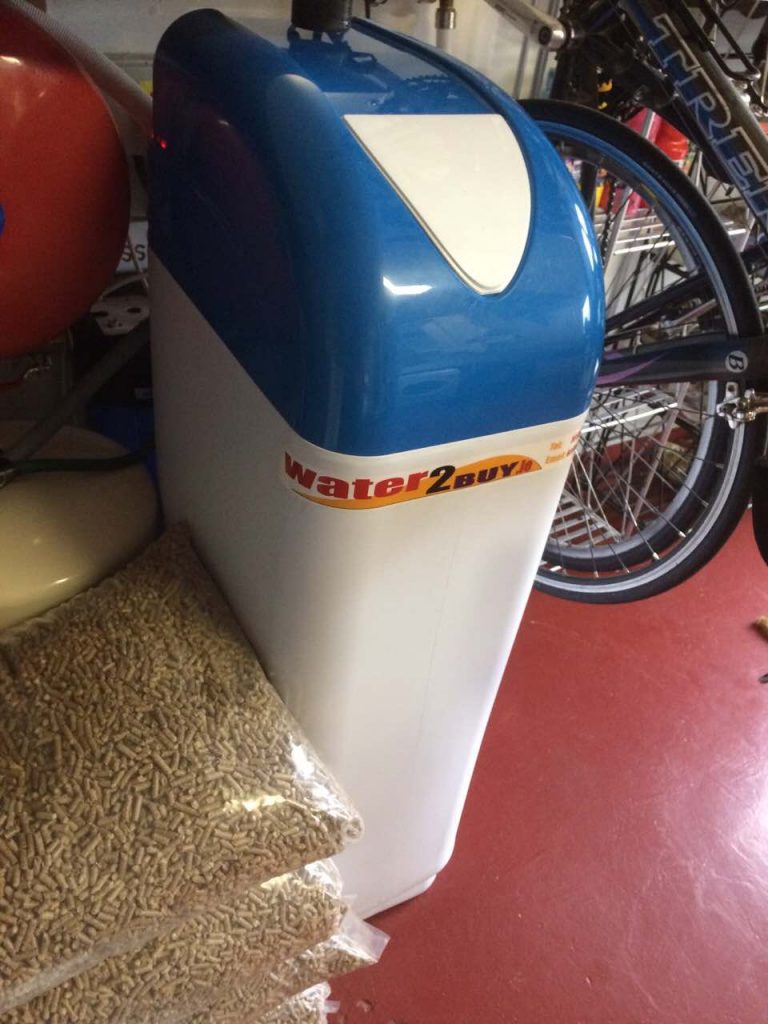 eing able to confirm that it would do the job.
eing able to confirm that it would do the job.
It turned out to be one of those rare completely successful fixes! We are thoroughly satisfied and are iron/manganese/lime free after 1.5 years of running now. As with all ion exchange processes the ions being exchanges with the unwanted contaminants need to be replenished – usually with rock salt. Through use of low flow fittings/toilets throughout our house we are down to approximately 1 x 20kg bag every 2 months. We didn’t opt for the more expensive flow based meter to set the flushing frequency, and instead went for the time based meter which just flushes at preset times regardless of the consumption. With some tweaking we managed to get it down to the point where it’s just enough to maintain the resin and so not much salt is being wasted.
The installation was easy and cost €80 with a local plumber to fit the additional lines to put the filter inline and also allow a bypass for when we needed to work on it.
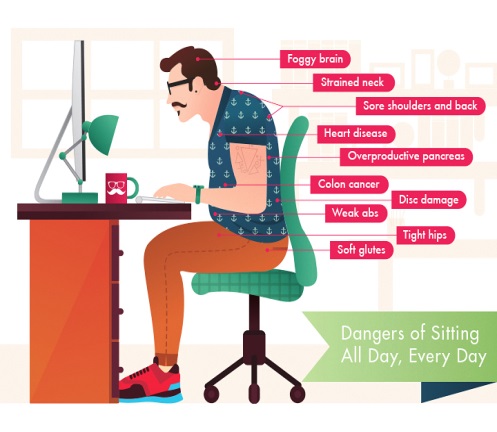
by wemakedo | Sep 23, 2016 | health |
In this post we stray a little from our recent interests in self sufficiency and minimizing waste to discuss a health concern we learned about that we felt important enough to share.
There is a lot of recent writing about the dangers associated with a sedentary lifestyle. Those of us who spend our day sitting at a desk or in front of a computer are told that we should exercise more. But what if the problem is not just the lack of exercise, but the actual sitting itself? It does seem somewhat intuitive that sitting down and hunching over a PC for hours during the day is not really what our bodies were meant to be doing. The convention at most office workplaces has meant that we now sit for up to 8 hours each day with few breaks, then drive home (seated) and possibly sit for more hours in the evening for relaxation. I myself have spent many hours doing so for nearly 20 years now. Thankfully I work for a company that is very aware of the ergonomic risks associated with the standard desk work setup and much effort is spent on educating people about the risks of repetitive strain injuries. This may help prevent aches and pains, but what about the more serious risks?
I came across this article and discovered it was one of many summarizing the newly identified dangers associated with sitting for extended periods.
To highlight some findings in the article:
One study compared adults who spent less than two hours a day seated (in front of the TV or other screen-based activity) with those who logged more than four hours a day of recreational screen time. Those with greater screen time (seated time) had:
- A nearly 50 percent increased risk of death from any cause
- About a 125 percent increased risk of events associated with cardiovascular disease, such as chest pain (angina) or heart attack
To me, these are shocking numbers caused by something considered so benign. The article goes on to say that these damaging effects are not counteracted by gym time or other exercise – the damage from sitting is done and remains. Some other headlines declared that sitting was “the new smoking”. I knew I had to do something about this.
Standing desks are nothing new, but in my experience they were reserved for people with significant back problems and the standing office arrangements tended to be prescribed for those issues. I was so bothered by the apparent health effects that I had to try this out. Getting a state of the art electrically adjustable standing / seating desk will cost from €1000 upwards, and so I wanted to be sure I could or would stick with this for the longer term before spending the money.
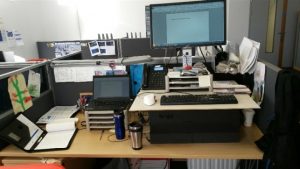 You can see my DIY version here. I am happy to report it works very well. Those are packing Styrofoam blocks under a board that my keyboard is sitting on. The height should be such that your elbows are at approximately 90 degrees w
You can see my DIY version here. I am happy to report it works very well. Those are packing Styrofoam blocks under a board that my keyboard is sitting on. The height should be such that your elbows are at approximately 90 degrees w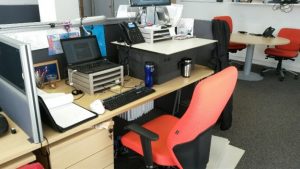 hen using the keyboard, and the monitor top should be at your eye level. In my case I had the luxury of being able to leave space for my laptop at a lower level as well as being able to easily switch the mouse and keyboard from the higher position to the lower position providing the easy option to sit when I wanted. This turns out to be necessary. I’m now sitting only 10-20% of the time I’m in front of the computer.
hen using the keyboard, and the monitor top should be at your eye level. In my case I had the luxury of being able to leave space for my laptop at a lower level as well as being able to easily switch the mouse and keyboard from the higher position to the lower position providing the easy option to sit when I wanted. This turns out to be necessary. I’m now sitting only 10-20% of the time I’m in front of the computer.
Standing for hours has its own risks and, depending on your physical condition, can tire you out quickly, so the best option would seem to be a mix of standing and sitting. The big advantage of standing for some of the work day is that, apart from keeping your metabolism running at a higher rate, you tend to move around a lot more on your feet, which is exactly why standing is so much better for your body.
Six months into my experiment and going strong, I have noticed:
- I work a little more efficiently as when standing I seem to be more attentive to what I’m doing and more eager to finish it.
- My posture has improved (shoulder droop is slowly reversing) – this seems to happen naturally as it’s more comfortable when standing to keep your back straight.
- I will more quickly walk away to do something I need to do as opposed to mentally deciding when seated, that you can wait until you need to get up to go do that thing. Walking up to your standing desk to engage in work, instead of flopping into a comfy chair seems to keep your brain more alert and attentive.
- I don’t get any post lunch slump anymore…you know that low energy feeling when a heavy lunch is being digested. Maybe it’s because standing and associated movements trigger metabolic processes that might otherwise stall while you are sitting and digesting your lunch
I should point out though that I did have some minor back pain during the first two weeks of doing this. It may just have been due to not adjusting my heights (keyboard, monitor) just right initially and then tweaking these over time. Or is may have been as simple as my back, curved over years by seated computing (see the image at the start of the article), was realigning and strengthening in areas it needed to use to keep me standing. Anyway, it passed, and now I have no hint of any back pain. But if you try this, be aware that you may experience this and may need to push through it, or it may be your body telling you that standing for lengths of time isn’t for you.
I do highly recommend giving this a try as I can honestly say I feel the benefits every day now, and I know it’s better for me. In a few years we may wonder at how we allowed this sedentary workplace practice to go unchecked for so long.

Also note that you can purchase cheaper standing alternatives like this one (Varidesk pro plus 30) to get you going, or as we prefer here at WeMakeDo…making your own from odds and ends is a very easy task and potentially life extending!

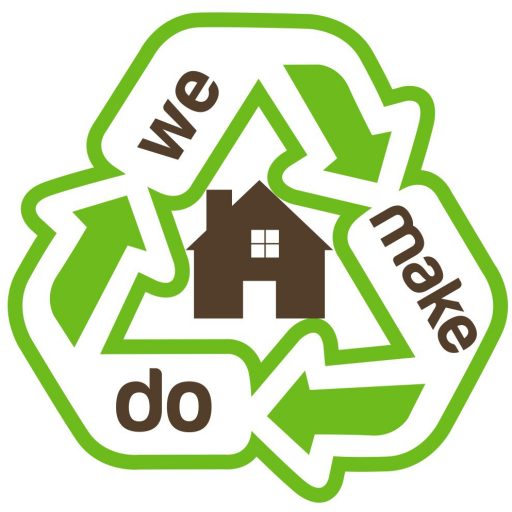



 A little background on the IPCC report: this report was commissioned in 2015 after the Paris Climate Accord when it was not really clear what would happen if the world were to limit the global temp increase to 1.5C above pre-industrial temperatures (before 1900) versus limiting it to 2C. This report was requested to go figure out the real world scenarios in both cases.
A little background on the IPCC report: this report was commissioned in 2015 after the Paris Climate Accord when it was not really clear what would happen if the world were to limit the global temp increase to 1.5C above pre-industrial temperatures (before 1900) versus limiting it to 2C. This report was requested to go figure out the real world scenarios in both cases.






